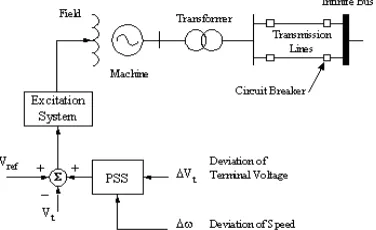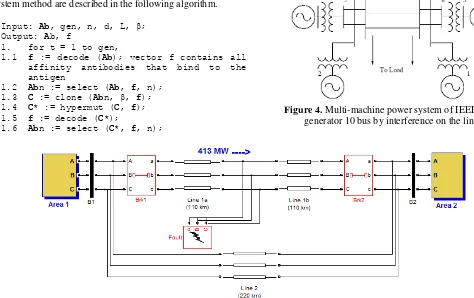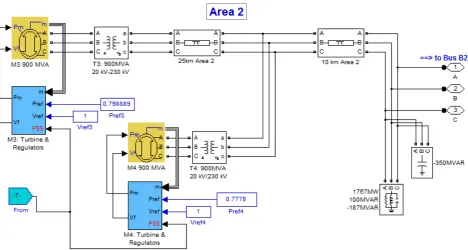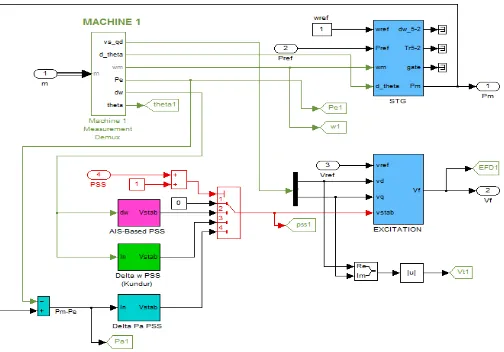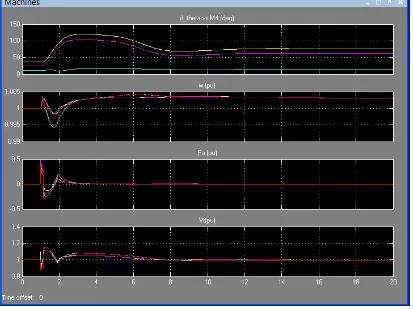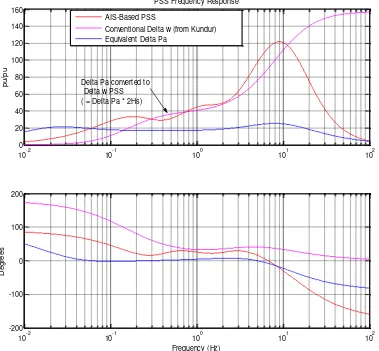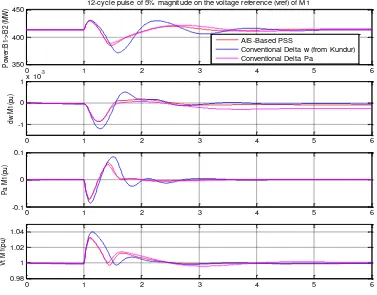Power System Stabilizer Model Using Artificial Immune System for Power
System Controlling
Ramadoni Syahputra
Department of Electrical Engineering, Faculty of Engineering, Universitas Muhammadiyah Yogyakarta, Indonesia.
Indah Soesanti
Department of Electrical Engineering and Information Technology, Universitas Gadjah Mada, Indonesia.
Abstract
This paper presents power system stabilizer (PSS) model using artificial immune system (AIS) for power system controlling. PSS is a device that can be used to improve the damping of power system during low frequency oscillations. This study proposed the use of AIS algorithm for tuning the PSS parameter. AIS-based PSS has been successful in controlling the multi-machine under study. For multi-machine system consists of four machines, the application testing on the machine M1 to short circuit symmetrical three-phase, AIS-based PSS found that that good design results in this study. Overall, AIS-based PSS, Delta w PSS and Delta Pa PSS gives relatively good results in reducing oscillation system variables of which transfer electrical power, changes in angular velocity generator, and the generator terminal voltage. AIS-based PSS have the performance relatively better than Delta w PSS and Delta Pa PSS in terms of ability to reduce oscillation and speed of reaching a state of instability. Based on testing can be seen that AIS-based PSS rapidly deliver good results compared Delta w PSS and Delta Pa PSS primarily on the state of the system.
Keywords—Power System Stabilizer, Artificial Immune System, transient stability, damping oscillation, multi-machine power system.
INTRODUCTION
Electrical power systems are often operated in critical situations that may lead to instability problems and in worst-case blackouts [1]-[3]. Large interruptions have historically occurred in many of electric power systems around the world, especially in Indonesia [4]-[6]. This may lead to panic and state of emergency in the society, something to be avoided. Because of today climate change, the Indonesian governments have decided that at least 23 % of the energy production must come from renewable energy sources by 2025 [7]-[12]. In operation, the electrical power system is often impaired the short circuit system to maintain synchronization at the time of interruption and after interruption occurs [13] – [15].
Power System Stabilizer (PSS) is a device that serves to maintain the stability of the electric power system [16]. In power systems, the PSS used to mitigate system damping of low-frequency oscillations is an important control objective for optimization design. For tuning of linear parameters of PSS such as gain and time constants, the conventional tuning processes are based on the linear approaches such as the eigenvalue analysis have been used [17]. However, by focusing only on a small signal state, the dynamic damping of oscillation performance immediately following a large disturbance is often degraded. The output limits of PSS can provide a solution to balance theses competing effects. In particular, these limit values of PSS parameters attempt to prevent the machine terminal voltage from falling below the exciter reference level while the speed is also dropping, which means that it can improve the reduced transient recovery after a disturbance [18].
POWER SYSTEM STABILIZER
In power system, large electric power system is generally a multi-machine system connected to an infinite bus. By electric power system in growth, the more vulnerable to interference, especially interference short-circuit. One effect is the oscillation of power that will cause the system out of the area of stability and can result in an even worse as a total blackout. The probability of occurrence of short circuit in transmission line for the various types of interference that is to disruption by 5% for three-phase fault, two-phase to ground fault by 10%, phase to phase fault by 15%, and one phase to ground fault by 70%.
Generally, the stability of electric power system is characterized into both steady state stability and transient stability. Transient stability associated with the major interruption that occurs suddenly, like a short circuit, line disconnection, and removal or disconnection of the load. Then, the steady state stability associated with the ability of the power system to return to the conditions of its operating point after a small disturbance or rejection such as changes in power or load smoothly. The steady state stability is also named
“dynamic stability”. Small changes in load will result in a
change in the angular velocity of the rotor, resulting change in machine terminal voltage. The angular velocity will swing around speed and voltage synchronous machine terminal converging around its rating voltage.
In the large multi-machine system, a system is said to be dynamically stable if there is after disturbance the difference in the angle of the rotor head at a certain finite value. If there is a difference between the rotor angles progressively enlarged then the system is unstable. Due to changes in the load on dynamic stability studies are relatively small, the multi-machine power system model used in this study is a non-linear models were linearized. Small change in load on the multi-machine power system is a matter that could not be avoided and it is always the case. Therefore, it is necessary to design a power system controller that can maintain the power system remains stable, commonly called Power System Stabilizer (PSS).
The basic function of PSS is to expand the limits of stability by modulating the generator excitation to produce oscillation damping rotor synchronous motor. The power oscillation usually occurs within a frequency range of about 0.2 to 3.0 Hz, and can interfere with the power rotor frequency. Therefore, the ability of the system to transmit electrical power can be deteriorated. In order to damp these oscillations, PSS must be able to produce electric torque according to the rotor speed changes. One example of the application of PSS in addressing the stability of the power system is shown in Figure 1.
Figure 1. Application of PSS in a machine
One example of PSS models is refers to the IEEE 421.5 standard, known as Multi-Band Power System Stabilizer (MB-PSS), as shown in Figure 2. In the PSS model has applied three kinds of filters are low-pass filter, intermediate-pass filter, and high-intermediate-pass filter, which serves to damp the local oscillation, the oscillation between networks, and global oscillations. By the PSS, the effect on the stability of the signal due to changes in the turbine power can also be suppressed.
Figure 2. Diagram block of a MB-PSS Stabilizer
ARTIFICIAL IMMUNE SYSTEM
Artificial immune system theory is used to explain the basic response of the immune system by being adaptive to antigen stimulation, as described in Figure 1. This theory states that the only cells able to recognize antigens that will proliferate, while other cells are ignored. Clonal selection operates on B cells and T cells in cell B, when the antibody binds to the antigen then activated and differentiated into plasma cells or memory cells. Prior to this process, B cell clones are produced and undergo somatic hyper-mutation. The result obtained diversity in the population of B cells to plasma cells produce antibodies antigen-specific works against antigens. Memory cells remain with host antigens and promote secondary response quickly.
The main features of the clonal selection of artificial immune system theory are:
a. new cells are duplicates of those parents (clone) which is charged with the rapid mutation mechanism height (somatic hyper-mutation),
b. elimination of the new different lymphocyte making it the self-reactive receptors,
c. proliferation and differentiation takes place through contact adult cells with antigen, and
d. the persistence of illegal clones, resistant to early algorithm, population or repertoire of receptors should be diverse enough to recognize any form of foreign cells. A mammalian immune system contains a heterogeneous repertoire of about 1012 lymphocytes in humans, and the rest of
B cells (stimulated) can display about 105-107 identical
like-antibody receptor. Repertoire has been believed complete means that he can recognize the shape of any cell.
In [11], they have proposed the clonal selection algorithm named ClonalG for learning and optimization. They discussed the main features of the theory of clonal selection and develop algorithms include the maintenance of a set of specific memory, selection and cloning antibodies are most stimulated, death antibody non-excitatory, maturation affinity and selection of re clones are balanced against affinity antigen, and the generation and maintenance of a set of antibodies.
The main steps of clonal selection of artificial immune system method are described in the following algorithm.
Input: Ab, gen, n, d, L, β; different techniques such as matching rules and a measure of distance. One common technique used is the Euclidean distance, which is suitable when using a real-valued vector representation.
METHODOLOGY
In this work, there is a multi-machine power system that are consists of two fully symmetrical areas. The areas are linked together by two 230 kV power transmission lines of 220 km length. It was specifically designed to study low frequency electromechanical oscillations in large interconnected multi-machine power systems. In this model, there are four machines which are interconnected in a system. Despite its small size, it mimics very closely the behavior of typical machine power systems in actual operation. The multi-machine power system circuit diagram in this study is shown in Figure 5. The multi-machine power system of IEEE standard consists of 4 generator 10 bus by interference on the transmission line.
Figure 4. Multi-machine power system of IEEE for 4 generator 10 bus by interference on the line
Figure 6. Components of area 1 of multi-machine power system under study
Figure 7. Components of area 2 of multi-machine power system under study
The load of the system is represented as constant impedances and split between the two areas in such a way that area 1 is exporting 413MW to area 2. The system is somewhat stressed, even in steady-state, because the surge impedance loading of a single line is about 140 MW. The reference load-flow with machine M2 considered the slack machine is such that all generators are producing the active power about 700 MW each. In this study, the losses of transmission and generation may
Figure 8. Model of PSS in Machine 1 of area 1 of multi-machine power system under study
RESULTS AND DISCUSSION
Multi-machine Power System Analysis for Small Signal In this study, multi-machine power system analysis for small signal is performed. In order to understand behavior of the network, the open-loop responses to a 5%-magnitude pulse, is applied for 12 cycles at the M1 voltage reference. This simulation is started by opening the timer controlling the M1 voltage reference and changing the factor of multiplication of the transition times vector from 100 to 1. Then, the transmission line fault should be deactivated by changing from 1 to 100 the factor of multiplication of the transition time vector in the fault device and transmission line breackers. After that, the signals responses are visualized by opening the scopes of "Machine" and "System" scopes on the main diagram as shown in Figure 5.
The signals of the system scope have been shown in Figure 9 while the signals of the four machine scopes have been shown in Figure 10. All signals of the Figure show undamped oscillations leading to un-stability. A modal analysis of acceleration powers of machines shows the three dominant modes, i.e.:
a. Mode of interarea-mode (fn = 0.66Hz , z = -0.028) involving the whole area 1 against area 2. This mode is clearly
observable in the tie-line power displayed in scope of "System".
b. Area 1 for local mode (fn = 1.14Hz, z = 0.09) involving this area's machines against each other.
c. Area 2 for local mode (fn = 1.17Hz, z = 0.09) involving machine M3 against M4 (the smaller the inertia then the greater the local natural frequency).
Figure 9. The signals of the system scope under simulation
10-2 10-1 100 101 102
Figure 11. Bode plot of all PSS under simulation
Tuning of PSS for Multi-machine Power System
The AIS-based PSS setting in this research was built in simulink-matlab software. As a comparison to the AIS-based, it has been simulated another PSS scheme, i.e. delta w PSS and delta Pa PSS, as shown in Figure 8. The results of bode plot of all PSS scheme is shown in Figure 11. The setting of Delta w PSS settings are from Kundur [18]. The PSS settings have two changes i.e. a gain increase from 20 to 30 and the addition of a 15-ms transducer time constant. The frequency responses of these PSSs can be seen on Bode Plot of the PSS in Figure 11. From the figure, it can be seen that the AIS-based PSS is effectively flat around 20-40 degrees in the frequency range of interest.
For Delta w PSS, it has an overall poor phase shape, especially around 1-2 Hz. Therefore, there makes it unable to cope with faster local or inter-machine modes in multi-unit power plants. For Delta Pa PSS, it has a good combination of strong gain and phase advance above 0.3 Hz. The PSS type is unpractical at low frequency where it shows a 180 degrees phase advance, which actually has a destabilizing effect despite the rather small low-frequency gain.
Small-Signal Performance Assessment of PSS
0 1 2 3 4 5 6
) 12-cycle pulse of 5% magnitude on the voltage reference (vref) of M1
0 1 2 3 4 5 6
Figure 12. 12-cycle pulse of 5% of voltage reference magnitude of machine M1
CONCLUSIONS
In our study, AIS-based PSS has been successful in controlling the multi-machine under study. For multi-machine system consists of four machines, the application testing on the machine M1 to short circuit symmetrical three-phase, AIS-based PSS found that that good design results in this study. Overall, AIS-based PSS, Delta w PSS and Delta Pa PSS gives relatively good results in reducing oscillation system variables of which transfer electrical power, changes in angular velocity generator, and the generator terminal voltage. All PSS can work well in order to stabilize the system which is basically unstable system. However, AIS-based PSS have the performance relatively better than Delta w PSS and Delta Pa PSS in terms of ability to reduce oscillation and speed of reaching a state of instability. Based on testing can be seen that AIS-based PSS rapidly deliver good results compared Delta w PSS and Delta Pa PSS primarily on the state of the system.
REFERENCES
[1] Syahputra, R., Soesanti, I., Ashari, M. (2016). Performance Enhancement of Distribution Network with DG Integration Using Modified PSO Algorithm. Journal of Electrical Systems (JES), 12(1), pp. 1-19.
[2] Syahputra, R., Robandi, I., Ashari, M. (2014). Optimization of Distribution Network Configuration
with Integration of Distributed Energy Resources Using Extended Fuzzy Multi-objective Method. International Review of Electrical Engineering (IREE), 9(3), pp. 629-639.
[3] Syahputra, R., (2012), “Distributed Generation: State
of the Arts dalam Penyediaan Energi Listrik”, LP3M
Approach for the Improvement of Distribution
Network Efficiency by Considering DG”, International
Journal of Computer Science & Information Technology (IJCSIT), Vol. 4, No. 2, pp. 57-68. [7] Syahputra, R., Robandi, I., Ashari, M. (2014).
“Optimal Distribution Network Reconfiguration with Penetration of Distributed Energy Resources”,
Proceeding of 2014 1st International Conference on Information Technology, Computer, and Electrical Engineering (ICITACEE) 2014, UNDIP Semarang, pp. 388 - 393.
Using Extended Particle Swarm Optimization Algorithm. International Review of Electrical Engineering (IREE), 10(2). pp. 293-304.
[9] Soedibyo, Ashari, M., Syahputra, R. (2014), Power loss reduction strategy of distribution network with distributed generator integration. 1st International Conference on Information Technology, Computer, and Electrical Engineering (ICITACEE) 2014, UNDIP Semarang, pp. 404 – 408.
[10] Syahputra, R., Robandi, I., Ashari, M. (2015). PSO Based Multi-objective Optimization for Reconfiguration of Radial Distribution Network. International Journal of Applied Engineering Research (IJAER), 10(6), pp. 14573-14586.
[11] Syahputra, R., Robandi, I., Ashari, M., (2012),
“Reconfiguration of Distribution Network with DG
Using Fuzzy Multi-objective Method”, International Conference on Innovation, Management and Technology Research (ICIMTR), May 21-22, 2012, Melacca, Malaysia.
[12] Syahputra, R., Robandi, I., Ashari, M., (2011),
“Modeling and Simulation of Wind Energy Conversion System in Distributed Generation Units”. International
Seminar on Applied Technology, Science and Arts (APTECS). 2011; pp. 290-296.
[13] Syahputra, R., Robandi, I., Ashari, M., (2011), “Control
of Doubly-Fed Induction Generator in Distributed Generation Units Using Adaptive Neuro-Fuzzy
Approach”. International Seminar on Applied
Technology, Science and Arts (APTECS). 2011; pp. 493-501.
[14] Jamal, A., Syahputra, R., (2011), “Design of Power
System Stabilizer Based on Adaptive Neuro-Fuzzy
Method”. International Seminar on Applied Technology,
Science and Arts (APTECS). 2011; pp. 14-21.
[15] Jamal, A., Syahputra, R. (2012), “Adaptive Neuro
-Fuzzy Approach for the Power System Stabilizer Model in Multi-machine Power System”, International Journal of Electrical & Computer Sciences (IJECS), Vol. 12, No. 2, 2012.
[16] Jamal, A., Syahputra, R. (2011), “Model Power System
Stabilizer Berbasis Neuro-Fuzzy Adaptif”, Semesta Teknika, Vol. 14, No. 2, 2011, pp. 139-149.
[17] Jamal, A., Suripto, S., Syahputra, R. (2015). Multi-Band Power System Stabilizer Model for Power Flow Optimization in Order to Improve Power System Stability. Journal of Theoretical and Applied Information Technology, 80(1), pp. 116-123.
[18] Utomo, A.T., Syahputra, R., Iswanto, (2011),
“Implementasi Mikrokontroller Sebagai Pengukur Suhu Delapan Ruangan”, Jurnal Teknologi, 4(2).
[19] Jamal, A., Syahputra, R. (2014). Power Flow Control of Power Systems Using UPFC Based on Adaptive Neuro Fuzzy. IPTEK Journal of Proceedings Series. 2014; 1(1): pp. 218-223.
[20] Syahputra, R. (2016). Application of Neuro-Fuzzy Method for Prediction of Vehicle Fuel Consumption.
Journal of Theoretical and Applied Information Technology (JATIT), 86(1), pp. 138-149.
[21] Syahputra, R., Robandi, I., Ashari, M., (2013),
“Distribution Network Efficiency Improvement Based
on Fuzzy Multi-objective Method”. International Seminar on Applied Technology, Science and Arts (APTECS). 2013; pp. 224-229.
[22] Syahputra, R., Robandi, I., Ashari, M. (2015). Reconfiguration of Distribution Network with DER Integration Using PSO Algorithm. TELKOMNIKA, 13(3). pp. 759-766.
[23] Syahputra, R., (2013), “A Neuro-Fuzzy Approach For
the Fault Location Estimation of Unsynchronized Two-Terminal Transmission Lines”, International Journal of Computer Science & Information Technology (IJCSIT), Vol. 5, No. 1, pp. 23-37.
[24] Syahputra, R., (2010), “Aplikasi Deteksi Tepi Citra
Termografi untuk Pendeteksian Keretakan Permukaan
Material”, Forum Teknik, Vol. 33, 2010.
[25] Syahputra, R. (2015). Simulasi Pengendalian Temperatur Pada Heat Exchanger Menggunakan Teknik Neuro-Fuzzy Adaptif. Jurnal Teknologi, 8(2), pp. 161-168.
[26] Syahputra, R. (2010). Fault Distance Estimation of Two-Terminal Transmission Lines. Proceedings of International Seminar on Applied Technology, Science, and Arts (2nd APTECS), Surabaya, 21-22 Dec. 2010, pp. 419-423.
[27] Soesanti, I., Syahputra, R. (2016). Batik Production Process Optimization Using Particle Swarm Optimization Method. Journal of Theoretical and Applied Information Technology (JATIT), 86(2), pp. 272-278.
[28] Syahputra, R., Soesanti, I. (2016). Design of Automatic Electric Batik Stove for Batik Industry. Journal of Theoretical and Applied Information Technology (JATIT), 87(1), pp. 167-175.
[29] Syahputra, R., Robandi, I., Ashari, M., (2014),
“Distribution Network Efficiency Improvement Based
on Fuzzy Multi-objective Method”. IPTEK Journal of Proceedings Series. 2014; 1(1): pp. 224-229.
[30] Syahputra, R. (2015). Characteristic Test of Current Transformer Based EMTP Shoftware. Jurnal Teknik Elektro, 1(1), pp. 11-15.
[31] Jamal, A., Syahputra, R. (2013). UPFC Based on Adaptive Neuro-Fuzzy for Power Flow Control of Multimachine Power Systems. International Journal of Engineering Science Invention (IJESI), 2(10), pp. 05-14.
[32] Syahputra, R., Robandi, I., Ashari, M. (2014). Performance Analysis of Wind Turbine as a Distributed Generation Unit in Distribution System. International Journal of Computer Science & Information Technology (IJCSIT), Vol. 6, No. 3, pp. 39-56.
Doubly-Fed Induction Generator. International Journal of Applied Engineering Research (IJAER), 11(7), pp. 4999-5004.
[34] Syahputra, R., Soesanti, I. (2015). “Control of
Synchronous Generator in Wind Power Systems Using Neuro-Fuzzy Approach”, Proceeding of International Conference on Vocational Education and Electrical Engineering (ICVEE) 2015, UNESA Surabaya, pp. 187-193.
[35] Syahputra, R., Soesanti, I. (2016). DFIG Control Scheme of Wind Power Using ANFIS Method in Electrical Power Grid System. International Journal of Applied Engineering Research (IJAER), 11(7), pp. 5256-5262.
[36] Syahputra, R., Soesanti, I. (2015). Power System Stabilizer model based on Fuzzy-PSO for improving power system stability. 2015 International Conference on Advanced Mechatronics, Intelligent Manufacture, and Industrial Automation (ICAMIMIA), Surabaya, 15-17 Oct. 2015 pp. 121 - 126.
